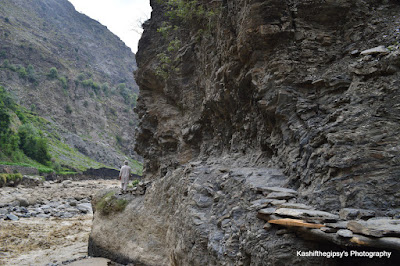Flooding in Rumbur Valley (Chitral-Pakistan) as
I Have Seen (2015)
Text and Photographs: Muhammad Kashif Ali
The
flooding phenomenon is not newer for the Kalasha valleys of Hindu Kush Range,
Chitral Pakistan but intensity and chaos in ecological system is a big
question. I am visiting all three Kalasha valleys (Bumboret, Rumbur &
Birir) since 2007 for academic research in domain of cultural history of the
region (earlier for my MPhil and currently for my Ph.D). There were floods in
the valleys before 2010 but not roaring and crushing flooding rather “soften”
floods with least harm to valleys and dwellers.
Fetching water from muddy springsSince 2010 the people of all three Kalasha valleys are under roaring pressure of respective rivers flowing in Bumboret, Rumbur & Birir valleys, with hardships they restore their lives in a year hardly and again stuck and hit by havoc flooding from high pastures where hundreds of hundreds goats and sheep ignite floods with their hundreds of thousands tiny hooves.
Flood struck homes (Palarog Village, Rumbor Valley)
I
had a plan to stay in Rumbur valley for academic data collection for a month in
July and August, to materialize the plan I left my home town with my family
(including three kids of 10, 7 and 2 years ages) for Chitral on July 13, 2015
and the same day first wave of the flood hit Chitral & adjacent valleys.
From July 13, 2015 to August 04, 2015 (as long was my stay) there with help of
my native friends I counted some 40 waves of floods in Rumbur Valley causing
damaging dozen of fields, houses, washing away bridges, destroying patches of
roads, hitting water mills and demolishing water channels, in nutshell
paralyzing normal life in Rumbur one of the Kalasha valleys.
Flood struck orchard (Rumbor Valley)
The
floods in Rumbur flow downwards from four high pastures: Bahuk, Ostuee,
Chimiksunn and Gangalwaat. These high pastures are habitat of Pine, Cedar,
Juniper and Oak largely. However, for four or five decades, as my local
informant told, the timber mafia is massacring the jungles cold-bloodedly and
the slopes of meadows are getting naked and vulnerable to inviting unexpectedly
flooding.
Jeep track of Rumbur Valley is washed away
Due
to continuous flooding and disconnecting Rumbur valley from Chitral town the
shops (might be counted on finger tips) got abandoned in couple of weeks and
the valley was on brink to hunger when a chopper of Pakistan Army landed in
valley to distribute relief ration provide by National Disaster Management
Authority (NDMA). My family also had to collect ration from relief package for
survival.
The lonely jeep track of Rumbur Valley is washed away
During
my stay in the valley the Army chopper visited the valley just twice but it was
not going to fulfill the basic needs of the valley, the people were in
miserable situation, the watermills had been damaged and people had to fetch
ration form relief or nearby bazar Ayun. They were adopting mountain top route
on foot about 25 to 30 km, one side. And when we had to leave valley for our
survival, my poor kids also had to adopt the same route and the lady was also
not familiar with such unfriendly trekking.
Local community repairs water channel by themselves
The
flash flood badly affected the tourism season in the valley. A bounty number of
tourists visit Kalasha valleys during summer and especially during Eid
vacations. The local and international tourists mark the Kalasha valleys as
their fascinating destination for their culture and natural beauty. Alas! The
shopkeepers, guides, guesthouse owners in valleys were looking towards tourists
but flood abruptly shattered their plans and dreams. The brutal Rumbur River
engulfed number of fields with crops and definitely it will cost livelihood and
food for valley fellow and their cattle in coming winter.
Tourist leaving valley via mountain top route on foot (est. 30 km)The flood could be softened if:
·
Stop deforestation & a strict
ban on cutting trees
·
Plantation on naked slopes and along
with river
·
Providing alternative fuel for
winter survival
·
Reducing number of goats & sheep
·
Constructing defensive walls
alongside the river
All
this can happen with participation of local people, the people need capacity
building regarding ecology system, climatically change, importance of forests.
And, obviously the people need alternative sources of income as currently they
rely upon pastures agriculture largely while on tourism partially. I strongly
feel the fruits, dry fruits processing units may be installed, mineral water
plants may be another option for employing the local population. The local
community should have proper proportion in services. With all these efforts we
may lessen their dependence over high pastures which may prevent the area from
brutal flooding which was not common before 2010. Let’s try to give a safer
future to our future generations.
Originally published online by Chitral Times on November 16, 2015 but without photographs, here is online story http://www.chitraltimes.com/english15/chitral-news-3574.htm.
The author is Lecturer in History at University of Gujrat-Pakistan, perusing PhD and is accessible via m.kashif@uog.edu.pk.








